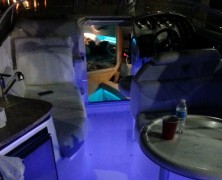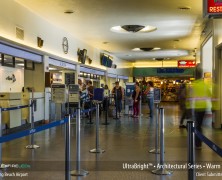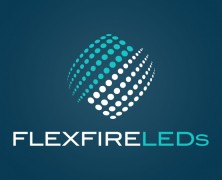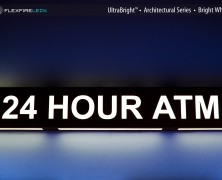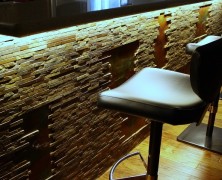Looking to increase your boat lighting’s functionality and/or “bling” factor? If so, you’re not alone — we here at Flexfire LEDs get calls all the time with questions about installing LED strip lights in boats and yachts. So many in fact, that we’ve decided to share a few ideas and address some of the more common issues with this sort of installation. Whether you’re running a skipper or a barge, taking your boat out for pleasure or for fishing, LED strip lights are a great solution for low energy lighting that can be fully customized to meet the individual size and lighting demands of your boat. The first thing to consider when looking into LED strip lights for your boat is to determine whether the lights will be exposed to environmental elements such as water or sand. If you’re considering LED strips for your deck lighting, or perhaps outside of the hull, make sure the lights are rated for outdoor use and water protection. Each of our LED strip lights has an IP rating that specifies the amount and type of protection it receives from the elements. IP ratings consist of two numbers — the first number refers to the amount of protection against solid objects, and the second refers to liquid protection. The numbers for solid object protection run from 0 (no protection) through 6 (full protection), while the numbers for liquid protection run 0 through 8. A fully waterproof LED strip light would thus have a rating of IP68. For deck accent lighting, we suggest our colorful, customizable and versatile IP65 Outdoor ColorBright™ LED strip lights, which come in static red, green and blue, as well as remote-controlled color changing RGB. Many people call us looking to generate the attractive indirect glow they’ve seen on other boats. To achieve this...
Flexfire LEDs UltraBright Strip Lights at California’s Long Beach Airport...
posted by Flexfire LEDs
LED strip lights are renowned for their ability to produce attractive indirect light in a small package, which made them perfect for this installation at a historic and architectural landmark. Civil engineer Stephan Lum was placed in charge of the project, choosing to install Flexfire LEDs UltraBright Strip Lights at California’s Long Beach Airport. As part of a larger renovation effort, the plan was to update the airport’s historic Art Deco terminal, which was originally built in 1941. Designers were keen to upgrade the terminal’s lighting without disturbing its original design, which made it necessary to avoid the use of contemporary light fixtures. Our high quality LED strip lights were a perfect solution; the strips themselves are hidden from view, and provide ample indirect light while also being highly durable and energy efficient. Our strip lights were installed above the check-in counters, into cove channels and in the airport news and gift shop to create a generous, inviting atmosphere for travelers on their way to their next flight. Designers were thrilled with the results, opting to install additional Flexfire LEDs strip lights around trees in the airport’s outdoor palm garden. Jeff Mills of Elec-Tech Electrical Contractors was placed in charge of this outdoor installation, attaching our Bright White UltraBright™ Outdoor Design Series Strip Lights to a dimmer for complete control of brightness level and energy usage. These outdoor LED strip lights feature IP weatherproof coating that protects them from water, dust, and other environmental hazards. The tree display was originally intended for the Christmas season only, but officials decided to leave it up indefinitely after positive public response. Check out more project photos below, or see the installation for yourself next time you’re passing through the Long Beach Airport! ...
Flexfire LEDs Announces High CRI LED Strip Lights...
posted by Flexfire LEDs
In keeping with its commitment to providing innovative LED lighting solutions, California-based Flexfire LEDs has announced its new UL Listed UltraBright™ High CRI Series LED Strip Lights. Designed to meet today’s higher lighting quality standards, this new line measures >93 on the color rendering index, fortifying the company’s reputation for delivering cutting edge technology at consumer-friendly prices. CRI, or color rendering index, is the standard measure of a luminaire’s ability to accurately render a specific color spectrum in comparison with a perfect reference source at a given color temperature (i.e. daylight). Simply put, if you direct the light onto a particular object, how natural do its colors look? Testing for CRI is a complicated process, requiring specialized machinery designed specifically for this purpose. Lamps are tested in terms of how they render eight basic colors (or “R values”), termed R1 through R8. A score from 0-100 is given for each color, and these eight numbers are then averaged to determine the lamp’s overall CRI rating. Those measuring above 90 are generally considered highly effective at rendering natural color; for a practical understanding, many of the traditional fluorescent lights that people consider “harsh” or “artificial” measure in the 60-70 CRI range. LED lighting is the established industry leader in energy efficiency, and advanced technological development means LED products are now available at dramatically lower prices than even just a few years ago. This dynamic is driving a worldwide shift to LED lighting, one that is further accelerated by government regulations such as those found in California’s Title 24. Established by the State’s Energy Commission, Title 24 addresses a number of energy efficiency standards, particularly those having to do with lighting. To be classified as “High Efficacy” and thus qualify for utility rebates and other advantages,...
LED Signage Lighting
posted by Flexfire LEDs
If your company has a physical office or storefront, chances are you’ve at least looked into commercial signage at some point. If you already have a sign, chances are equally high that you’ve dealt with increased maintenance and energy costs as well as burnt out bulbs and tubes. As many business owners are discovering, these issues are now being addressed thanks to the versatility of LED signage lighting. Because of their tiny size, LED chips can be aligned and configured in a variety of ways to illuminate infinite shapes of indoor and outdoor commercial signage. Flexfire LEDs strip lights, for instance, are perfect for this sort of installation. They are thin, flexible, and come with adhesive backing, meaning they can be applied to follow various angles such as those found in channel lighting. With optional IP weatherproofing, LED strip lights are also resistant to water and dust. It’s important to note that unlike other lighting technologies, LEDs produce direct, precise illumination, a big part of why they’re used in televisions and smartphones. For this reason, LEDs are a perfect backlighting source for letters and company logos in box sign applications as well. Additionally, improved technology means that the initial cost of LED lights has been dramatically reduced over the past few years, removing what has been the main barrier for many business owners. There are four main advantages to using LED lighting for commercial signage as opposed to fluorescent or neon tubes: energy efficiency, durability, safety, and overall light quality. Let’s start by addressing energy efficiency, as it directly affects your company’s bottom line. Energy Efficiency High quality LED and fluorescent signage products are both capable of producing in excess of 100 lumens per watt, meaning they will produce a great deal of light...
LED Strip Lights: Top 5 Concerns For Lighting Designers...
posted by Flexfire LEDs
LED strip lights deliver extreme versatility in a compact, low profile package. Their customizability is popular with creative lighting professionals everywhere, and this popularity promises to expand greatly as LED prices continue to fall. Obvious applications for flexible strip lights include above cabinet and under counter lighting, and the list continues to grow thanks to increased product development and innovation efforts. Here, therefore, is a quick checklist of the top 5 concerns for lighting designers to compare and choose among different LED strip light products. 1. Lumens Per ____? Every project is different, so determine what matters most before comparing overall lumen output. Lumens per watt, for instance, is most important for LEED and energy-efficient installations, while others may be more concerned with lumens per foot, meter, or reel. 2. CRI Customizable LED chips can be configured to produce a wide variety of lighting conditions. High quality LED strip lights are now capable of producing a color rendering index of 90 and above, rivaling the top lighting options found anywhere on the market today. 3. Certification Choose products that are UL or ETL Listed (U.S. and Europe, respectively), and provide the appropriate LM testing information from the Illuminating Engineering Society to certify claims regarding things like luminous intensity and CRI. 4. Dimming Capability Whether through a simple wall switch or smartphone mobile app, clients want the ability to adjust their lights using a dimmer. Professional grade LED strip lights should be compatible with desired dimming options. 5. Quality of Components LED chip design, heat sink, and PCB quality are among the factors that differentiate one LED strip light from another. These affect light quality, degradation and longevity, not to mention product safety. Look for a supplier who stands by his...






